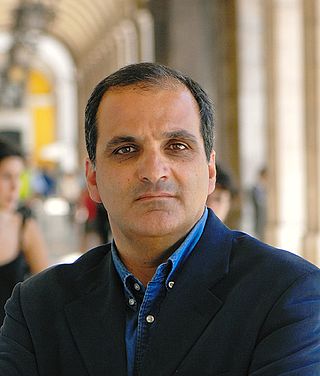Related Research Articles
Lusitanian mythology is the mythology of the Lusitanians, an Indo-European speaking people of western Iberia, in what was then known as Lusitania. In present times, the territory comprises the central part of Portugal and small parts of Extremadura and Salamanca.
The Lusitanians were an Indo-European-speaking people living in the far west of the Iberian Peninsula, in present-day central Portugal and Extremadura and Castilla y Leon of Spain. After its conquest by the Romans, the land was subsequently incorporated as a Roman province named after them (Lusitania).

Ataegina was a goddess worshipped by the ancient Iberians, Lusitanians, and Celtiberians of the Iberian Peninsula. She is believed to have ruled the underworld.
Trebaruna, also Treborunnis and possibly *Trebarunu, was a Lusitanian deity, probably a goddess. Trebaruna's cult was located in the cultural area of Gallaecia and Lusitania.

The mythology of the ancient Basques largely did not survive the arrival of Christianity in the Basque Country between the 4th and 12th century AD. Most of what is known about elements of this original belief system is based on the analysis of legends, the study of place names and scant historical references to pagan rituals practised by the Basques.

Francisco Manuel Trigoso de Aragão Morato, best known as Francisco Trigoso was a Portuguese liberalist politician. He presided over the Portuguese government from 1 August to 6 December 1826.

Mirobriga or Mirobriga of the Celts was an ancient town in the westernmost part of Lusitania during the Iron Age and Roman Times that was mentioned by Pliny the Elder and Ptolemy.

The National Museum of Archaeology is the largest archaeological museum in Portugal and one of the most important museums devoted to ancient art found in the Iberian Peninsula. Located in Lisbon, the museum was founded in 1893 by the archaeologist José Leite de Vasconcelos. The museum is located in the western wing of the Jeronimos Monastery where the monks had their dormitory. The museum is built in the Neo-Manueline style and was officially opened in 1906.

The Fountain of the Idol is a Roman fountain located in the civil parish of São José de São Lázaro, in the municipality of Braga, northern Portugal. Located in the former territory of the Callaici Bracari, the granite rock fountain/spring has Latin inscriptions, dedicated to the Gallaecian and Lusitanian gods Tongoenabiagus and Nabia.
Dom Heliodoro de Paiva was a Portuguese composer, philosopher, and theologian.

Bombay Before the British (BBB) was a three-year research project in the fields of History of Architecture and History of Urbanism, funded by the Portuguese Ministry of Science, Technology and Higher Education through its Science and Technology Foundation (FCT).

José Maria de Sousa Horta e Costa, CavA, OA, OSE, also known as José Maria de Sousa Horta e Costa (de) Almeida e Vasconcelos, was a Portuguese soldier, politician, and diplomat. He was colonial Governor of Macau and India.
Miguel António de Sousa Horta Almeida e Vasconcelos, 2nd Baron of Santa Comba Dão was a Portuguese nobleman.
António Maria de Sousa Horta e Costa was a Portuguese jurist, magistrate, and politician.
António Osório Sarmento de Figueiredo Jr. was a Portuguese nobleman, jurist, politician and magistrate.

FEUP Fado Group is a Portuguese student group that performs Fado

Walter Rossa is architect, urban planner, researcher and Professor of University of Coimbra.
The Castro of Castelo Velho is a Chalcolithic settlement in the civil parish of Terena, municipality of Alandroal in the Alentejo Central area of the Portuguese Alentejo.
The Faculty of Philosophy, Languages and Human Sciences is a unit of the University of São Paulo, Brazil. It offers undergraduate and graduate courses in philosophy, social sciences, history, geography, literature, languages and linguistics. It was founded in 1934 as the Faculty of Philosophy, Sciences and Languages.

The Panóias Sanctuary, also called "Fragas de Panóias", is located in Vale de Nogueiras, in the municipality of Vila Real, Portugal, a few kilometres from the city
References
- ↑ Monteiro Teixeira, Sílvia. 2014. Cultos e cultuantes no Sul do território actualmente português em época romana (sécs. I a. C. – III d. C.). Masters’ dissertation on Archaeology.. Lisboa: Faculdade de Letras da Universidade de Lisboa.[ page needed ]
- ↑ Encarnação, José d’. 2015. Divindades indígenas sob o domínio romano em Portugal. Second edition. Coimbra: Universidade de Coimbra.[ page needed ]
- ↑ Monteiro Teixeira, Sílvia. 2014. Cultos e cultuantes no Sul do território actualmente português em época romana (sécs. I a. C. – III d. C.). Masters’ dissertation on Archaeology.. Lisboa: Faculdade de Letras da Universidade de Lisboa.[ page needed ]
- ↑ Encarnação, José d’. 2015. Divindades indígenas sob o domínio romano em Portugal. Second edition. Coimbra: Universidade de Coimbra.[ page needed ]
- ↑ Monteiro Teixeira, Sílvia. 2014. Cultos e cultuantes no Sul do território actualmente português em época romana (sécs. I a. C. – III d. C.). Masters’ dissertation on Archaeology. Lisboa: Faculdade de Letras da Universidade de Lisboa.[ page needed ]
- ↑ Encarnação, José d’. 2015. Divindades indígenas sob o domínio romano em Portugal. Second edition. Coimbra: Universidade de Coimbra.[ page needed ]
- ↑ Vasconcellos, José Leite de. Religiões da Lusitania na parte que principalmente se refere a Portugal . Lisboa: Imprensa nacional, 1897. pp. 124-125.
- ↑ Álvarez Sanchís, Jesús (2003). Los Vettones. Real Academia de la Historia. p. 320. ISBN 9788495983169.
- ↑ Encarnação, José d’. 2015. Divindades indígenas sob o domínio romano em Portugal. Second edition. Coimbra: Universidade de Coimbra.[ page needed ]
- Loução, Paulo Alexandre: Portugal, Terra de Mistérios, Ésquilo, 2000 (third edition; ISBN 972-8605-04-8).
- Vasconcellos, José Leite de. Religiões da Lusitania na parte que principalmente se refere a Portugal . Lisboa: Imprensa nacional, 1897. pp. 111-145.

